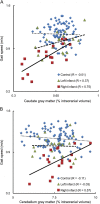Infarct hemisphere and noninfarcted brain volumes affect locomotor performance following stroke
- PMID: 24489132
- PMCID: PMC3959753
- DOI: 10.1212/WNL.0000000000000186
Infarct hemisphere and noninfarcted brain volumes affect locomotor performance following stroke
Abstract
Objective: Brain damage within the right middle cerebral artery (MCA) territory is particularly disruptive to mediolateral postural stabilization. The objective of this cross-sectional study was to test the hypothesis that chronic right MCA infarcts (as compared to left) are associated with slower and more bilaterally asymmetrical gait. We further hypothesized that in those with chronic right MCA infarct, locomotor performance is more dependent on gray matter (GM) volumes within noninfarcted regions of the brain that are involved in motor control yet lie outside of the MCA territory.
Methods: Gait speed was assessed in 19 subjects with right MCA infarct, 20 with left MCA infarct, and 108 controls. Bilateral plantar pressure and temporal symmetry ratios were calculated in a subset of the cohort. GM volumes within 5 regions outside of the MCA territory (superior parietal lobe, precuneus, caudate, putamen, and cerebellum) were quantified from anatomic MRIs.
Results: Right and left infarct groups had similar poststroke duration (7.6 ± 6.0 years), infarct size, and functional independence. The right infarct group demonstrated slower gait speed and greater asymmetry compared to the left infarct group and controls (p < 0.05). In the right infarct group only, those with larger GM volumes within the cerebellum (r(2) = 0.32, p = 0.02) and caudate (r(2) = 0.56, p < 0.001) exhibited faster gait speed.
Conclusion: Individuals with chronic lesions within the right MCA territory, as compared to the left MCA territory, exhibit slower, more asymmetrical gait. For these individuals, larger GM volumes within regions outside of the infarcted vascular territory may help preserve locomotor control.
Figures


Comment in
-
Volumes of intact gray matter outside the stroke predict gait performance.Neurology. 2014 Mar 11;82(10):822-3. doi: 10.1212/WNL.0000000000000194. Epub 2014 Jan 31. Neurology. 2014. PMID: 24489128 No abstract available.
References
-
- Jorgensen HS, Nakayama H, Raaschou HO, Olsen TS. Recovery of walking function in stroke patients: the Copenhagen Stroke Study. Arch Phys Med Rehabil 1995;76:27–32 - PubMed
-
- Patterson KK, Parafianowicz I, Danells CJ, et al. Gait asymmetry in community-ambulating stroke survivors. Arch Phys Med Rehabil 2008;89:304–310 - PubMed
-
- Chen CY, Hong PW, Chen CL, et al. Ground reaction force patterns in stroke patients with various degrees of motor recovery determined by plantar dynamic analysis. Chang Gung Med J 2007;30:62–72 - PubMed
-
- Titianova EB, Tarkka IM. Asymmetry in walking performance and postural sway in patients with chronic unilateral cerebral infarction. J Rehabil Res Dev 1995;32:236–244 - PubMed
-
- Cassvan A, Ross PL, Dyer PR, Zane L. Lateralization in stroke syndromes as a factor in ambulation. Arch Phys Med Rehabil 1976;57:583–587 - PubMed
Publication types
MeSH terms
Grants and funding
LinkOut - more resources
Full Text Sources
Other Literature Sources
Medical
